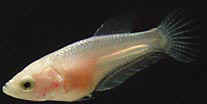The picture above shows a male and female Betta Breeding. The male is above the female and bent over her. The female is under the male, and released her eggs, which then floated up into the bubble nest on the surface of the water. The bubble nest had been built earlier by the male.
We shipped these Bettas from our facility to Brooke in Boston. She spawned them and sent us the picture of them spawning. Thanks again, Brooke.
Here is a list of nine things you really must know about breeding Beta Fish.
(2) Male and female Bettas should not be kept together except for an hour or two in a fish bowl or small aquarium, while they spawn.
(3) Keep each male in its own fish bowl. Click here to read more about fish bowls. Click here to buy a Fish Bowl Kit. Sometimes more than one Male Betta can live together in a large aquarium. But most experienced Betta Fish breeders keep each male in its own bowl.
(4) Female Bettas can be kept together in one aquarium as shown at the top of this page in a picture of a six-gallon aquarium, where twelve Female Bettas live together. Some experienced Betta breeds keep a few mild tempered males together in large aquariums with or without females. But some males are too aggressive and cannot be kept with other Bettas, except for a short time for breeding with a female.
(5) Most of the time we feed floating pellet food labeled for Betta Fish and freeze dried blood worms, which are mosquito larvae, to our male and female Bettas. Click here for more about these foods and feeding fish.
When we're ready to spawn our female Bettas, we feed them the following foods each morning and each evening in the order listed: BettaMin, Freeze Dried Blood Worms, some live or frozen brine shrimp, then a few live Black Worms. Click here to read more about Black Worms.
With good care and plenty of food the female Bettas will swell with eggs, and the good food will also encourage the Male Betta to build a big bubble nest. Sometimes I have been able to see pinkish eggs through the skin over the abdomen of plump females.
(6) Change 20% of the water each day in the bowls with the males and in the bowls or aquariums with females. This should stimulate the males to build bubble nests on the surface of the water along the edges of their bowls. You can see a bubble nest above the spawning Bettas in the photo just above. Click here for more information about how to change water in your fish bowl.
(7) Put your plumpest female in with the male that has built the biggest bubble. They will usually quarrel for a while. The male may rip the female's fins, she may nip him back, then he'll embrace her, and they'll spawn as shown in the picture above. You can see in the picture above that the male has ripped the females fins. You'll need to watch carefully to be sure that he doesn't hurt her too badly.
If they don't spawn, you should remove the female and put her back in the aquarium or fish bowl that she came from, or the male will probably hurt her. If they do spawn, you should still remove the female.
(8) The male Betta, not the female, will care for the eggs in the bubble nest. You will see him taking the eggs into his mouth where he cleans them with special natural chemicals in his mouth. Two days after spawning the chemicals in his mouth change and dissolve the outer layer of the eggs to release the fry.
(9) Now comes the difficult part. We were never able to raise the Betta fry in an aquarium or a bowl. Instead we put them in a pond. This only works when the water temperature is 68 degrees F. or warmer. The pond was often 70 degrees F. and warmer during the summer.
The pond was outdoors, contained no fish that might eat the tiny baby Bettas, and held about 500 gallons of water. I often looked at a drop of the pond water with a microscope, and the pond water was always full of lots of tiny living things, called infusoria. The baby Bettas eat what they like best from the assortment available in the pond water. Click here for more about ponds.
Here is a magnified picture of a 6-week old Betta. This picture was taken by Wayne Schmidt, who gave us permission to use it.
Click here to go to a page in Wayne Schmidt's web site, where there is a very interesting series of pictures, that shows a Betta growing from an egg to an adult in 11 weeks, and each picture is labeled with the age. Thanks Wayne for lots of amazing stuff on your web site!
2. Fish Bowl Kits for Sale
This Fish Bowl Kit contains one Betta of your choice, two Aquatic Snails, and three Live Plants. This Fish Bowl Kit makes a wonderful gift and a dramatic center piece for decorating.
Most importantly these Fish Bowls have been thoroughly tested by us to ensure the animals are compatible and can live indefinitely in this environment when given proper care. Click here for more about buying a Fish Bowl Kit for Bettas from us.
Click here to go on to another page in this web site with Customer Comments and our Replies about how to spawn Beta Fish.
Source: aquariumfish.net











